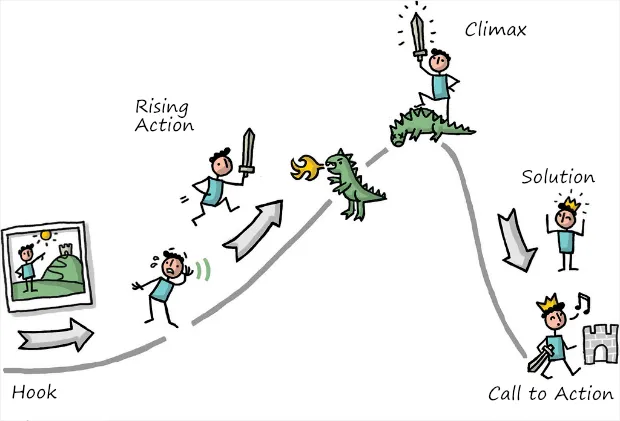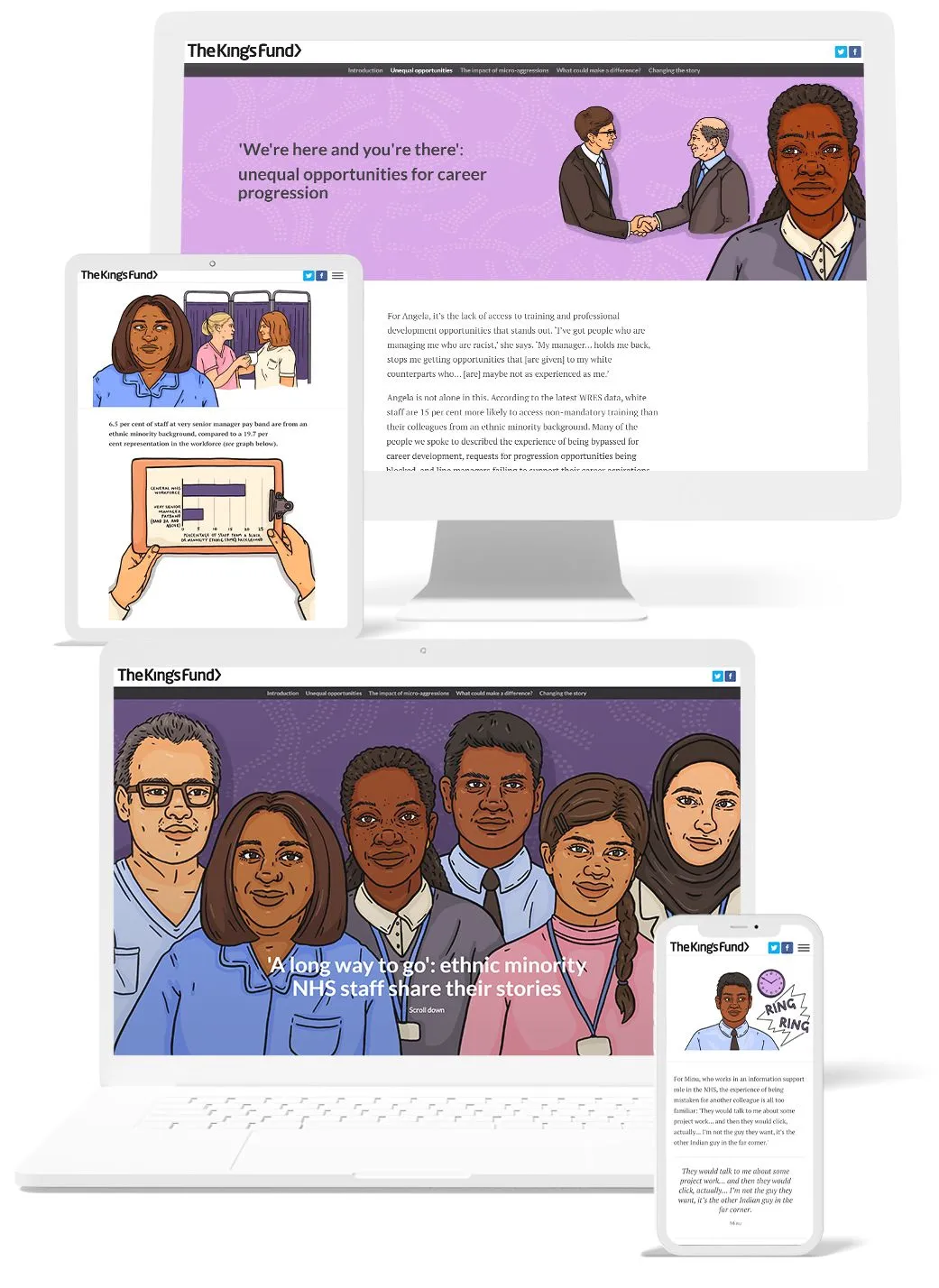Every person on Earth has core memories. These are stories tucked in our minds that make us feel and act. It's what makes us human! Stories trigger our senses and emotions. When we hear a good story, our oxytocin levels rise (which is good for us).
Sharing and hearing stories are part of our daily lives. We tell stories to friends, family, and even strangers. Our appearance and behavior also tell a story.
A study shows stories can be 22 times more memorable than plain facts!
This proves that stories have an acute impact on our brains and how we respond.
That’s why smart marketers use storytelling to connect with their audience more deeply.
Let’s look into the benefits of storytelling, which elements make a story impactful, the types of storytelling brands can use in advertising your brand, and the top tactics to invoke storytelling in your marketing materials.
Table Of Contents:
- What Is A Story?
- Why Is Storytelling Important In Advertising?
- What Makes A Good Story?
- 4 Essential Types Of Storytelling In Advertising
- 5 Practical Storytelling Techniques To Use In Advertising
- 4 Awesome Storytelling Advertising Examples
- Storytelling Cultivates Lasting Relationships
You can directly jump to a section of your choice or keep scrolling.
What Is A Story?
In this context, a story is any narrative that evokes emotions. A strong brand story speaks to the heart and conveys marketing messages in a way that mere descriptions can't.

Source: Mention
Why Is Storytelling Important In Advertising?
According to Search Engine Watch, 62% of B2B marketers find storytelling important in content marketing. Let's see why it's important and how it benefits your business.
- Stories capture consumers' attention and make them interested in your brand. You can share stories on different platforms, from ads to social media, podcasts to videos, and you will attract more buyers, especially if the story goes viral.
- Compelling brand stories connect with emotions to show people that you understand their needs. This humanizes your brand and builds community, empathy, and loyalty.
- Storytelling adds value to products and boosts sales. Highly engaged customers tend to stay and spend more to increase your revenue by 31%.
- Stories simplify complex concepts. They connect products with relatable ideas to improve customer understanding and drive interest.
Now you know how stories influence customer behavior and product promotion. So, keep reading to learn the elements of an excellent story.
What Makes A Good Story?
Consumers consider the story interesting when it tells about something important and relevant to them. However, it is not enough to make your storytelling engaging. Read below to learn what creates a really good story in this section.
Central Message & Plot
Define the main idea of the story you tell. It should be a strong morality that influences the listeners’ emotions and reminds them about the importance of certain things. Once you define this core message, build a plot around it. Your story needs a beginning, climax, and end. Remember that all these elements should be connected and describe the central message.
Conflict
It is impossible to create an engaging story without tension. You can combine internal and external conflicts to keep people on edge and motivate them to listen till the end. Describe the challenges your characters face while trying to reach their goals. It helps evoke the audience's feelings and connect consumers with your brand through impressive experiences.
Characters
Memorable personalities are one more necessary element in a good story. All characters should have their own goals, motivations, voices, strengths, weaknesses, challenges, and the ways they overcome them. Appearance is also very important. It should coincide with the inner world of the characters and distinguish them from each other. All personalities should play a certain role in the story and influence the plot.
Setting
Choose remarkable places that coincide with your characters’ personalities and help the plot develop. The setting should reflect the atmosphere of your story. For example, if the plot is mysterious - you can choose dark and strange places; if it is funny - the setting can be bright and attractive.
Rhythm & Structure
To keep listeners engaged, you should change the rhythm of the story. Mix long and short sentences, paragraphs, or scenes. Avoid monotonous narration. Also, your story should have a clear structure. It does not matter whether you tell the story orally, in writing, using visual elements, or even through play - a clear beginning, middle, and end of the plot are required. They should work together to transmit the central message of the story.
The Ending
The listeners need to have a clear understanding of the story’s resolution. It should not necessarily be a good one, but it should reflect the main idea of the plot. If you use storytelling in marketing, it is good to use a call to action at the end of the narrative. In such a way, you give the audience instructions about their future actions and come to the logical end of the story.
Understanding these elements can help you create persuasive stories to influence your audiences’ buying decisions. Let’s go further and look at the main types of storytelling and how to use them in marketing.
4 Essential Types Of Storytelling In Advertising
Storytelling isn't just about entertainment anymore. It's an influential tool for promoting brands. To use it well in marketing, let's understand the main types of storytelling.
Oral Storytelling
This is the oldest way of telling stories. It resembles singing songs or sharing tales in front of an audience. Today, it's alive through radio, podcasts, and social media platforms like TikTok and Instagram, where people share jokes and personal stories.
Written Storytelling
This is a common way of sharing stories. Think of books, newspapers, banners, and more. People read them for enjoyment, learning, and discovering new things. It's widely used in marketing through articles, blogs, and online content.

Source: Mention
Visual Storytelling
Pictures have been telling stories for ages. Now, visual storytelling includes movies, photos, videos, animations, and more. Brands use this a lot in ads and social media posts to share their stories.

Source: OptinMonster
Digital Storytelling
This is the newest way of storytelling advertising and it combines all the previous forms through the internet. Content marketing is a big part of it, using various types like photos, videos, articles, and more. Even games are used to tell stories as it turns people into active creators.

Source: Shorthand
Now you know the 4 types of storytelling and how to use them in marketing. Let's continue reading to learn the top techniques to boost your storytelling.
5 Practical Storytelling Techniques To Use In Advertising
According to research by a professor at Stanford University, stories are the most important way to deliver data. When his students heard a speech that included storytelling and facts, 63% remembered the stories and only 5% remembered individual statistics. This fact proves the ultimate strength of storytelling. Here's how to increase the impact of your storytelling:
Show What Happens & Use Scene-by-scene Construction
This tactic is the most useful in written storytelling. Instead of talking about the events, you should describe them.
Transport the audience to the scene, and make them hear and feel the same as your characters do.
It can help you immerse the readers into your story, engage them and influence their perceptions. Avoid missing some scenes and telling about them afterward. It is always better to show something than to state the fact of an event.
Make The Story Dynamic & Easy To Relate To
Evoke people’s emotions and feelings that are easy to understand. Don’t be afraid to show your or your brand’s weaknesses and the ways you overcome them. Such elements make your storytelling more personal and especially attractive. However, you should avoid irrelevant details that do not boost the plot or influence your characters to keep audiences’ attention all the time.
Define A Hero & An Enemy
Strong characters are one of the most important elements of the story. People always need someone they will support and someone they will hate. Sometimes bad characters can be things, natural phenomena, or events that do not let positive ones reach their goals.
The climax of the story is the biggest fight between the enemy and the hero.
Create A Feeling Of Suspense & Add Unexpected Events
It is also about continuous tensions that keep readers’ or listeners’ attention. You can create a non-linear storyline and start from the middle action or from the climax to hook the audience at once. Add surprises to your plot that keep conflict intensivе, make the audience empathize with the characters, and create a memorable story.
Improve Your Dialogues
It is one of the most challenging parts of the stories to write. Your characters should sound realistic and real and stay consistent in their voices and communicational styles. Also, do not use dialogues if they don’t serve the development of the plot. Some changes in the characters’ personalities or actions should happen after every communication.
Use these techniques to create strong stories that you can use in your blogs, social media, or promotional campaigns. In the next section, we provide examples of brands that used storytelling to boost their brand awareness.
4 Awesome Storytelling Advertising Examples
Using storytelling to promote your brand means creating stories that are interesting and convincing. These stories should connect with your audience and match your company's values. Below are examples of successful storytelling from well-known brands, along with what made them so impactful.
Apple
Apple's film 'Detour,' directed by Michael Gondry, promoted the iPhone 7 Plus camera features. The story follows a lost tricycle and shows the camera's capabilities. It's an 11-minute journey with unexpected happy twists. Apple's approach included providing online classes to help buyers create similar videos.
Disney
Disney's commercial, 'The Little Duck,' shows us how dreams can come true. The story revolves around a duckling who finds a comic book about Donald Duck and becomes fascinated by the character. Despite challenges, the duckling eventually finds a new home in Disneyland Paris and meets Donald Duck in real life. In just 75 seconds, this cute story charms us and leaves us feeling happy.
Coca-Cola
Coca-Cola used AR technology for a storytelling campaign. Just by pointing their phones at a Coca-Cola can, buyers could see short stories with conflicts and positive resolutions involving the brand. Augmented reality and storytelling were combined to create an interactive and successful advertising campaign.
Eva Stories
Not a promotional campaign, but Eva Stories is a striking example of storytelling with a huge social mission. It tells the story of 13-year-old Hungarian Jew girl Eva during the Holocaust through Instagram Stories. Based on Eva Heyman's real diary, the campaign educates people about this tragic period. With over a million followers, the stories gained 300 million views in under 48 hours, thus raising awareness about the Holocaust.
Storytelling Cultivates Lasting Relationships
Infusing storytelling into your sales and marketing strategy can set off a chain reaction of interest, focus, persuasion, and drive among your potential customers.
These key steps guide customers toward their final decision and result in a successful sale.
But don't treat storytelling as just a tactic or something to add later in your business plan.
Incorporate it into your company's values. Do business in a way that nurtures genuine and lasting connections with your customers.




Explore the Statusbrew range of social media tools
Cancel anytime!